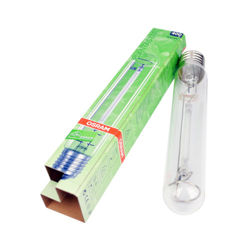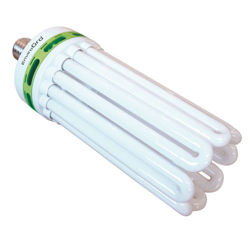Grow lights – types of lighting and tips for illumination.
Grow lights – types of lighting and tips for illumination.
In this article we present
HPS lamps
CFL lamps
Led grow lighting
Which lamp to choose?
Lamp color and plant growth
Commercial and home cultivation – what lamps to use?
Proper lighting setup for crops

HPS lamps
Only recently have sodium lamps come into the world of growing - before then they were mostly used for lighting streets. In recent years HPS lamps have become the most popular choice for home growers. HPS lamps support growth at every stage of development, from sprouting to blooming, providing saplings with energy necessary for photosynthesis.
HPS lamps
use the full spectrum of light from 280 nm to 1000 nm, this is why their light is so similar to natural sunlight. In reality the plant uses less than half of the light created by the high-energy bulbs during illumination. This comes from the plant’s need for particular length of light waves. HPS lights are also characterized by large heat production. To use a HPS lamp you first need to buy a power supply unit (known as ballast) and a reflector (for proper light distribution). Additionally, your sodium lamp needs to be well ventilated to reduce the heat produced by the bulb.

CFL lamps
Compact fluorescent lights, or CFL for short, are one of the least expensive solutions for home growers. Its biggest advantages are the relatively low price and ease of assembly (as opposed to HPS lamps, you don’t need to buy an extra power supply unit, you just need to screw the bulb into the reflector.
Another advantage of CFLs is their lower power consumption compared to HPS, which reduces the cost of home growing. The two major weaknesses are failure frequency and lower light penetration, which leads to inferior growth compared to both HPS and Led Grow.

Led Grow lighting
Led Grow is one of the newest and most efficient ways of illuminating plants in both professional and home settings. Led Grow lets you choose the perfect spectrum of wavelengths required for particular growth stages. Another advantage is the compact size of LED bulbs – the user doesn’t need any extra power supply or reflectors, just plug in the lamp or screw the bulb into a classic socket.
You can purchase separate lamps for particular growth stages – one for the growth phase, another for blooming and a UV booster to help fight pests. Alternatively, you can choose Led Grow lighting with a universal spectrum or the option to switch between growth and blooming phases. Led Grow allows you to achieve great harvests with minimal costs. For as strong as it is, Led Grow uses up very little electricity and is more durable than other lamps used for illumination.
Diode lifespan in Led Grow panels is up to 50 000 hours. It guarantees crop safety and long-term lighting reliability. In addition, thanks to new LED technology, you will save on water and expensive supplements, which evaporate in high-temperature environments. When choosing an LED lamp you need to remember, that the diodes don’t work at 100% capacity, which means the actual energy consumption will be lower than the one declared by the manufacturer (you need to pay attention to the power consumption directly from the wall)
Which lamp to choose?
The correct lighting setup can drastically improve your crop yield. There are a few types of illumination lamps. Every one of them has different specifications, efficiency and power consumption, among others
|
Type of lamp |
HPS |
CFL |
LED Grow |
|
light intensity |
high, consistent |
low |
smooth regulation |
|
lifespan |
around 10 000 hours |
8 - 10k hours |
50 - 100k hours |
|
light quality |
25 - 65 CRI |
60 - 80 CRI |
60 - 90 CRI |
|
area of use |
commercial cultivation |
supplementing natural light |
home and commercial cultivation |
|
pros |
high light output |
low price, easy assembly |
energy efficiency, reliability |
|
cons |
high power consumption |
unreliability, low light penetration |
high cost of assembly |
Lamp color and plant growth
Modern grow lamps offer a full spectrum of light, which has a positive effect on the process of photosynthesis. In the cultivation of most species red and blue light is key. One is responsible for blooming and seed creation, the other for the development of leaves and stems. It’s also good for the lighting setup to emit a small amount of infrared and ultraviolet (UV) light.
In the case of HPS and Led Grow the light color parameters can be configured according to the current needs of the plants. Crops need different things during various stages of development. CFL (or the less recommended UV) lamps are suited for illuminating plants, which still need access to sunlight. In their case the spectrum is narrow or its configuration is impossible.
Commercial and home cultivation – what lamps to use?
When looking for the perfect lamp for illuminating your crops it pays to focus not only on the price, but also the final cost of the investment. The energy consumption to light strength ratio is key. This especially applies to commercial cultivation with a large surface area, where optimizing costs and efficiency is very important. Other things to keep in mind are:
-
environmental impact, which is closely related to energy consumption,
-
optimal wavelength for growth and blooming phases,
-
assembly time and accessories,
-
maintenance related to lamp lifespan.
In the case of lamps for home cultivation, e.g. potted plants, the most important parameter is the spectrum of light and energy efficiency. LED bulbs and the less efficient CFLs are relatively inexpensive solutions. For larger plantations sodium and LED bulbs are particularly attractive options.
Among Grow Led products you can also find UB Booster lamps, which you mount next to ordinary bulbs in order to protect the saplings from mold and insects. UV radiation increases the production of glycosides, which effectively scare off insects.
Proper lighting setup for crops
Simply choosing the correct lamp for your crops isn’t everything. You also need to set them up in such a way that they don’t burn the saplings, but still provide them with ample lighting. There is no one perfect distance between the lamps and the crops. There are a few factors which might influence your choice:
-
bulb power,
-
type of lamp,
-
needs of the plants,
-
size of your grow and saplings.
The lux parameter, which describes the amount of lumens per square meter, will prove particularly helpful. For example, a 50 W bulb set up 60 cm from your crops will give off at the intensity of 1050 lux. Such a setup is optimal for shade-resistant plants. Species requiring more light will in turn need a shorter distance (15 cm for low and 30 cm for high demand).
